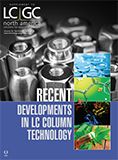Introduction: Beyond Particle Technology
Special Issues
An introduction to this special issue from the guest editor.
David S. Bell

Welcome to the 2018 edition of Recent Developments in LC Column Technology. Several significant advances have transpired in the field during the past decade. Two of the more significant technologies, sub-2-µm particles and superficially porous particles (SPP), have taken a firm hold on modern liquid chromatography practice. Each of these developments were initially met with both excitement and their share of skepticism. Both emotions drove extensive research and ultimately adoption of the ideas. Today, both technologies are routinely used in many industries around the world, but where do we go from here? This supplement was assembled to provide examples of the ongoing research that is building upon recent particle technology developments.
Ken Broeckhoven and colleagues discuss the current status of the most recently accepted advances in liquid chromatography (LC) technology. Further, the authors interpret the present state-of-the-art developments such as three-dimensional (3D) printing and microfabricated pillar arrays, noting that further fundamental research toward improvements are expected to continue.
There are often downsides when adopting new technologies. Thermal effects in ultrahigh-pressure liquid chromatography (UHPLC), for example, exhibit a negative impact on chromatographic performance. Fabrice Gritti describes a user-friendly column hardware design for use in both UHPLC and supercritical fluid chromatography (SFC) that promises to eliminate radial temperature gradients responsible for peak distortion.
In an effort to expand the utility of modern particle designs, Jason Anspach and colleagues examine the use of biocompatible column hardware aimed at minimizing undesired adsorption of target analytes. The authors compare PEEK and titania hardware to traditional stainless steel column designs in terms of analyte adsorption, pressure tolerance, chromatographic performance, and reproducibility.
Jordy Hsaio and colleagues discuss the expansion of particle technology in terms of novel surface chemistry developments. The group reports on the use of an SPP-based zwitterionic stationary phase for hydrophilic-interaction chromatography (HILIC) applications. This article is a good example of how the base particle technologies are impacting more than just traditional reversed-phase separations.
Lastly, new areas of application interest sometimes develop concurrently with new technology developments. Justin Steimling provides an excellent example using the cannabis industry. Because of limited legacy regulations and methods pertaining to various characterization needs, the cannabis industry is poised to take full advantage of modern particle technologies.
Advances in particle technologies are driving subsequent developments in hardware design and surface chemistry. Collectively, these developments are providing a positive influence on both mainstream and alternative modes of chromatography. With state-of-the-art technologies such as microfabricated pillar arrays and 3D printing on the horizon, advances that are even more significant may not be far away. Enjoy!

Accelerating Monoclonal Antibody Quality Control: The Role of LC–MS in Upstream Bioprocessing
This study highlights the promising potential of LC–MS as a powerful tool for mAb quality control within the context of upstream processing.
Using GC-MS to Measure Improvement Efforts to TNT-Contaminated Soil
April 29th 2025Researchers developing a plant microbial consortium that can repair in-situ high concentration TNT (1434 mg/kg) contaminated soil, as well as overcome the limitations of previous studies that only focused on simulated pollution, used untargeted metabolone gas chromatography-mass spectrometry (GC-MS) to measure their success.
Prioritizing Non-Target Screening in LC–HRMS Environmental Sample Analysis
April 28th 2025When analyzing samples using liquid chromatography–high-resolution mass spectrometry, there are various ways the processes can be improved. Researchers created new methods for prioritizing these strategies.
Potential Obstacles in Chromatographic Analyses Distinguishing Marijuana from Hemp
April 28th 2025LCGC International's April series for National Cannabis Awareness Month concludes with a discussion with Walter B. Wilson from the National Institute of Standard and Technology’s (NIST’s) Chemical Sciences Division regarding recent research his team conducted investigating chromatographic interferences that can potentially inflate the levels of Δ9-THC in Cannabis sativa plant samples, and possible solutions to avoid this problem.

.png&w=3840&q=75)

.png&w=3840&q=75)



.png&w=3840&q=75)



.png&w=3840&q=75)











